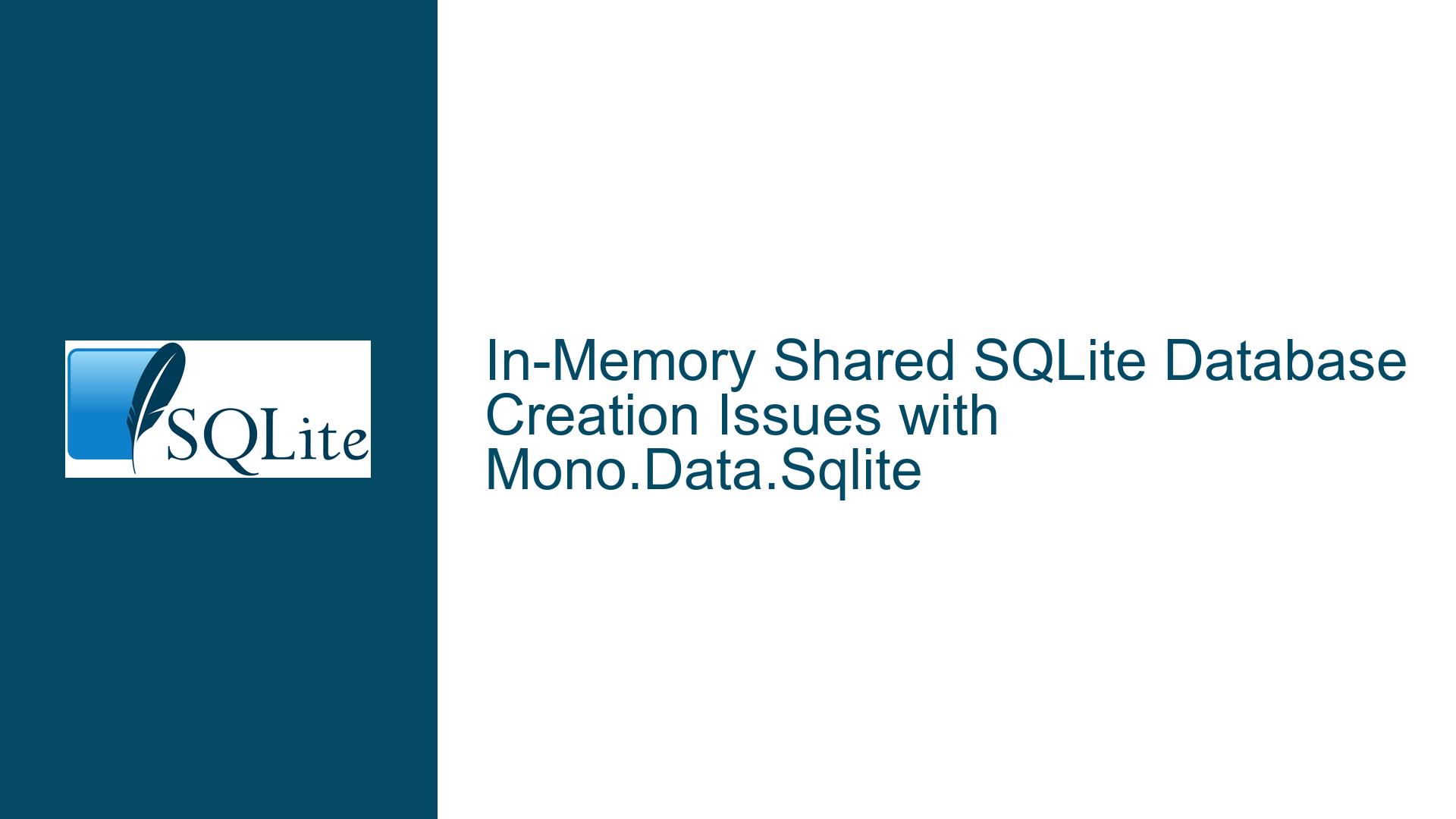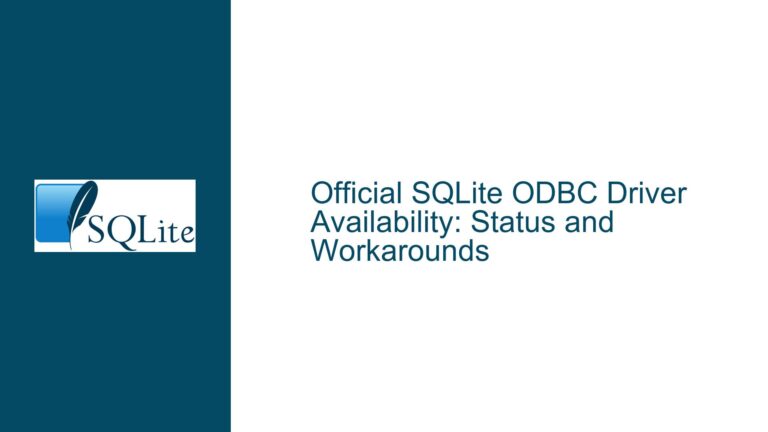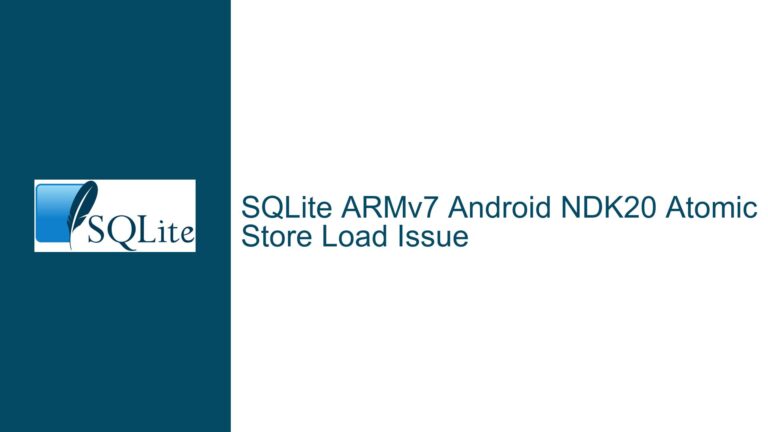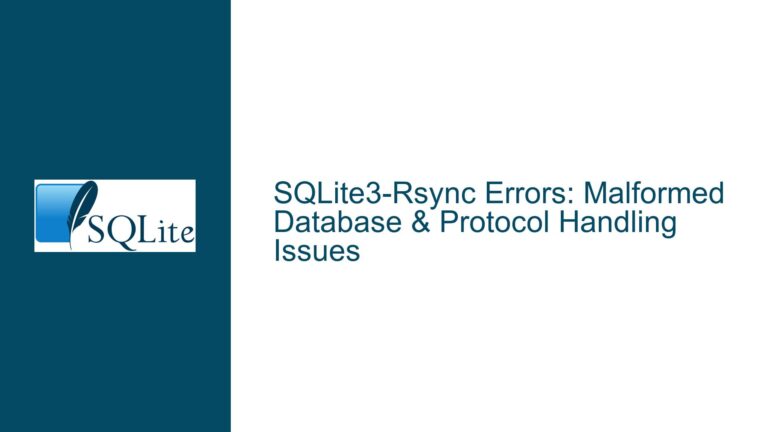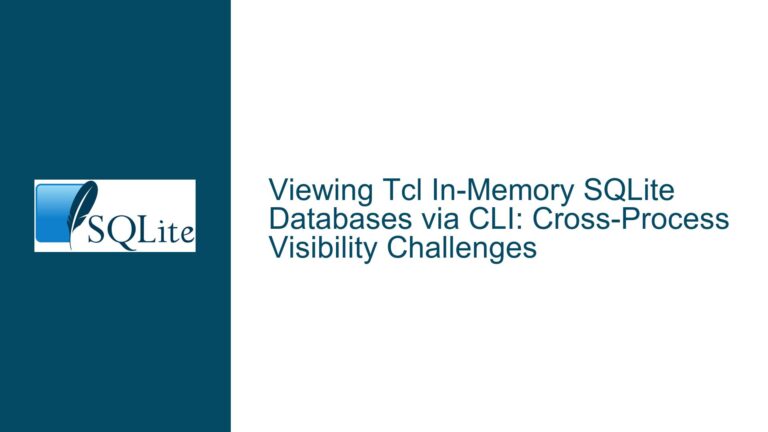In-Memory Shared SQLite Database Creation Issues with Mono.Data.Sqlite
In-Memory Shared Database Creation Fails with Mono.Data.Sqlite
Creating an in-memory shared database using Mono.Data.Sqlite can be a challenging task, especially when the database is unexpectedly created on the local hard drive instead of in memory. This issue often arises due to misconfigurations in the connection string or underlying library settings. The primary goal is to ensure that the database resides entirely in memory and is accessible across multiple connections within the same process. However, achieving this requires a deep understanding of SQLite’s in-memory database mechanics, URI filename handling, and the specific implementation details of Mono.Data.Sqlite.
The core problem revolves around the inability to create a shared in-memory database despite following the official SQLite documentation. Users often encounter errors such as "unable to open database file" or find that the database is being created on disk instead of in memory. This issue is compounded by the nuances of different .NET frameworks, such as System.Data.Sqlite, Microsoft.Data.Sqlite, and Mono.Data.Sqlite, which may implement SQLite features differently.
URI Filename Handling and SQLITE_USE_URI Compilation Flag
One of the most critical factors in creating an in-memory shared database is the proper handling of URI filenames. SQLite supports URI filenames, which allow for more flexible and powerful database connections, including in-memory databases. However, this feature must be enabled during the compilation of the SQLite library by defining the SQLITE_USE_URI flag. If this flag is not set, attempts to use URI-based connection strings will fail, leading to the creation of on-disk databases or errors such as "unable to open database file."
To determine whether URI filenames are enabled in your SQLite library, you can perform a simple test. Attempt to connect to a database using a URI filename, such as file:hello.db. If a file named hello.db is created on disk, URI filenames are enabled. If not, or if an error occurs, URI filenames are not enabled. Similarly, attempting to connect to file::memory: should result in an in-memory database. If a file is created on disk or an error occurs, URI filenames are not enabled.
In the context of Mono.Data.Sqlite, the issue may be further complicated by the specific implementation details of the library. While Mono.Data.Sqlite is designed to work with SQLite, it may not fully support all features, especially if the underlying SQLite library was not compiled with the necessary flags. This can lead to discrepancies between the expected behavior and the actual behavior when attempting to create an in-memory shared database.
Implementing PRAGMA journal_mode and Ensuring Cross-Process Memory Sharing
Another critical aspect of creating a shared in-memory database is the use of the PRAGMA journal_mode command. The journal mode determines how SQLite handles transactions and ensures data integrity. For in-memory databases, the MEMORY journal mode is often used, as it stores the journal in memory rather than on disk. However, this mode may not be suitable for all use cases, especially when cross-process memory sharing is required.
Cross-process memory sharing is a more advanced feature that requires customizing the Virtual File System (VFS) used by SQLite. The default VFS implementation for in-memory databases does not support cross-process sharing, meaning that each process will have its own separate in-memory database. To achieve cross-process sharing, you would need to implement a custom VFS that supports shared memory across processes. This is a non-trivial task that varies significantly across different platforms and requires a deep understanding of both SQLite and the underlying operating system.
In the context of Mono.Data.Sqlite, achieving cross-process memory sharing is even more challenging due to the additional layer of abstraction introduced by the .NET framework. The library may not provide direct access to the necessary low-level APIs required to implement a custom VFS. As a result, users may need to resort to alternative solutions, such as using a temporary file-based database or implementing inter-process communication (IPC) mechanisms to share data between processes.
Troubleshooting Steps, Solutions & Fixes
To resolve the issue of creating an in-memory shared database with Mono.Data.Sqlite, follow these detailed troubleshooting steps:
Verify URI Filename Support: Ensure that the SQLite library used by Mono.Data.Sqlite was compiled with the
SQLITE_USE_URIflag enabled. This can be done by attempting to connect to a database using a URI filename, such asfile:hello.db. If a file is created on disk, URI filenames are enabled. If not, you will need to recompile the SQLite library with theSQLITE_USE_URIflag or use a precompiled version that supports URI filenames.Correct Connection String Syntax: Use the correct syntax for the connection string when creating an in-memory shared database. The connection string should include the
Mode=MemoryandCache=Sharedoptions, and the database name should be prefixed with:memory:. For example:string connectionString = "Data Source=:memory:;Mode=Memory;Cache=Shared";Ensure that the options are spelled correctly and match the case used in the official SQLite documentation.
Check for Errors and Logs: If the database is still being created on disk or if you encounter errors such as "unable to open database file," check the error logs and messages for more detailed information. This can help identify specific issues with the connection string, URI filename handling, or other configuration settings.
Test with a Simple Example: Create a simple test program that attempts to create and access an in-memory shared database using Mono.Data.Sqlite. This can help isolate the issue and determine whether it is related to the library, the connection string, or other factors. For example:
using Mono.Data.Sqlite; using System; class Program { static void Main() { string connectionString = "Data Source=:memory:;Mode=Memory;Cache=Shared"; using (var connection = new SqliteConnection(connectionString)) { connection.Open(); using (var command = connection.CreateCommand()) { command.CommandText = "CREATE TABLE Test (Id INTEGER PRIMARY KEY, Name TEXT)"; command.ExecuteNonQuery(); command.CommandText = "INSERT INTO Test (Name) VALUES ('Sample')"; command.ExecuteNonQuery(); command.CommandText = "SELECT * FROM Test"; using (var reader = command.ExecuteReader()) { while (reader.Read()) { Console.WriteLine($"{reader["Id"]}, {reader["Name"]}"); } } } } } }Consider Alternative Libraries: If Mono.Data.Sqlite does not support the necessary features or if the issue persists, consider using an alternative .NET SQLite library, such as System.Data.Sqlite or Microsoft.Data.Sqlite. These libraries may have better support for URI filenames and in-memory shared databases.
Implement Custom VFS for Cross-Process Sharing: If cross-process memory sharing is required, consider implementing a custom VFS that supports shared memory across processes. This is a complex task that requires a deep understanding of SQLite and the underlying operating system. Alternatively, use IPC mechanisms to share data between processes.
Use PRAGMA journal_mode: Experiment with different journal modes to determine the best configuration for your use case. For in-memory databases, the
MEMORYjournal mode is often suitable, but other modes may be required depending on the specific requirements of your application.
By following these troubleshooting steps and understanding the underlying issues, you can successfully create an in-memory shared database using Mono.Data.Sqlite. The key is to ensure that URI filenames are enabled, use the correct connection string syntax, and consider alternative solutions if necessary. With careful attention to detail and a thorough understanding of SQLite’s in-memory database mechanics, you can overcome the challenges and achieve the desired outcome.
